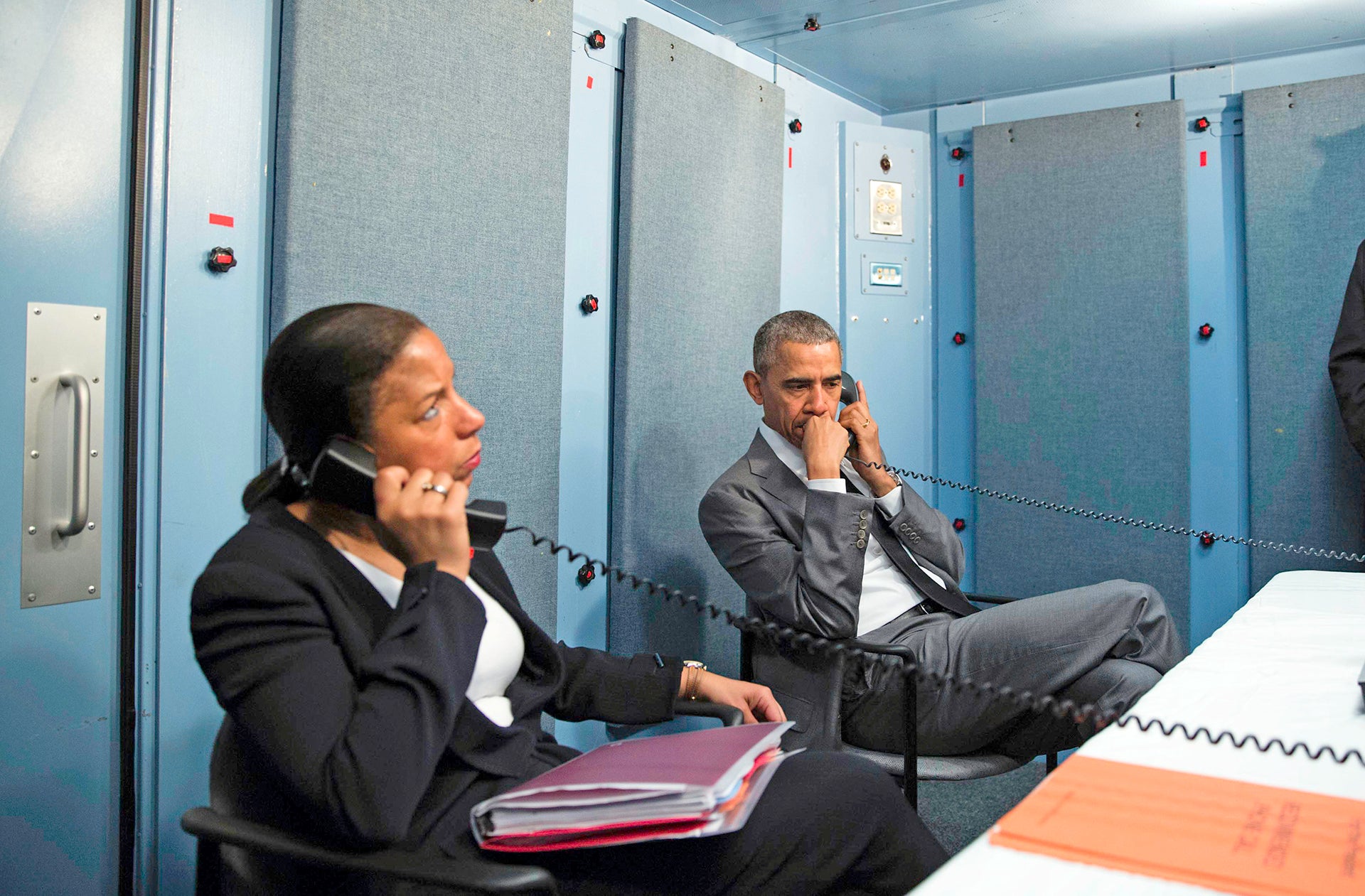An incredibly unique photo was snapped by White House photographer Pete Souza while President Obama was making his historic trip to Cuba last March. The shot shows Obama and National Security Advisor Susan Rice on the phone inside what appears to be an armored shipping container of sorts with padded walls. The photo was shot as the two discussed the terror attack is Brussels with Homeland Security Advisor Lisa Monaco via secure teleconference. Their location at the time of the photo was the Havana residence of the U.S. Chief of Mission in Cuba. What you are actually seeing in this photo is a glimpse inside of one of an unknown number of operational Sensitive Compartmented Information Facilities, often referred to as “SCIFs” or “vaults,” that belong to the US government around the globe.
SCIF’s are reminiscent of the famous “Cone of Silence” that was a recurring gag on Get Smart:

SCIFs are basically office areas built to certain government standardsso that sensitive information can be disseminated and discussed inside without being heard, seen or intercepted electronically. One contractor who builds these facilities describes them as such: “Sensitive Compartmented Information Facility (pronounced “skiff”), a U.S. Department of Defense term for a secure room. It can be a secure room or data center that guards against electronic surveillance and suppresses data leakage of sensitive security and military information. SCIFs are used to deny unauthorized personnel, such as foreign intelligence services or corporate spies, the opportunity for undetected entry into facilities for the exploitation of sensitive activities.” These facilities are built up to TEMPEST specifications, which are designed to keep sounds, electronic emissions, and vibrations from escaping, and thus potentially compromising what is happening inside.
The White House, embassies, intelligence installations, military bases, defense contractors, and even some non-defense or state related corporations have a need for SCIFs. As such, there is a cottage industry of contractors that build them in all types of configurations and scales.
In recent years, containerized SCIFshave become popular, as they can be transported anywhere in the world and are as close to a plug-and-play affordable option as any. Such a system is what Obama and Rice are using in the photo above. Yet SCIFs also include much larger or even smaller areas, that are custom built or retrofitted as part of a new or existing structure.


For instance, an entire group of rooms, or even a floor of a building—in fact even an entire large building itself—could be a SCIF or could contain a network of SCIFs. At American air bases around the world, large SCIFs allow pilots and aircrews to examine classified intelligence on enemy weapons systems, talk openly with other personnel about classified tactics and capabilities, and even brief and debrief entire missions. On a larger scale, entire intelligence centers and secure server farms can be built as giant SCIFs. Even vehicles can be designed to SCIF standards and containerized war rooms that can be quickly re-deployed around a theatre of combat exist so that commanders can plan battles under high-security. When heads of state travel abroad, tiny modular SCIFs are erected inside hotel rooms to keep spying governments from obtaining critical information.
Another rare shot showing Obama and his advisors in a tiny makeshift SCIF in a hotel room in Rio de Janeiro:

,
This rare look of a President inside one of these facilities, which is a far cry in terms of austerity from the accouterments of the White House Situation Room or the confines of Air Force One, is a reminder of the steps that are taken to keep sensitive information and command decisions secure. Yet these contraptions can only do their job if the materials and the principals that read those materials, or make command decisions, are inside them when these things happen.
Famously Secretary of State Hillary Clinton had her issues with using a non-government, unsecure server for email, which some classified information, or at least communications of a classified nature, moved through. It was an absurdly stupid and damning choice that could have resulted in severe consequences. Today, the Trump administration is under fire for possibly using private email accounts of their own, and also for the President’s use of an non-secure mobile phone, which is is becoming a major issue on Capitol Hill.
The issue of how the Trump administration handles classified information exploded further into the media spotlight today following photos taken and accounts given of how Trump and his team handled the aftermath of North Korea’s missile launch, which you can read about in detail here. During the incident, aids and cabinet members used cell phones to read supposedly very sensitive documents in the packed and dimly-lit dining room of Trump’s Mar-a-Lago club. Trump himself was said to have read vey sensitive information at the table in full view of the wait staff. Photos were also taken by guests of White House documents. The irony could not be more clear, as the same issue Trump made such a big deal about during the campaign in regards to Hillary Clinton, and rightfully so, is now infesting his own young administration.
Even if a SCIF was not present at the club to accommodate Trump’s national security team, which is highly unlikely considering how long the White House had to plan for being at the location frequently, an empty room with a closed door and decent lighting would have been a far better choice for looking at sensitive documents and for discussing major foreign policy decisions. If these allegations prove true, it marks an extreme lapse in security protocol not just by neophytes into the classified world, but by experienced professionals, that could damage Trump’s credibility when it comes to “being smart” about national security.
Contact the author: Tyler@thedrive.com
